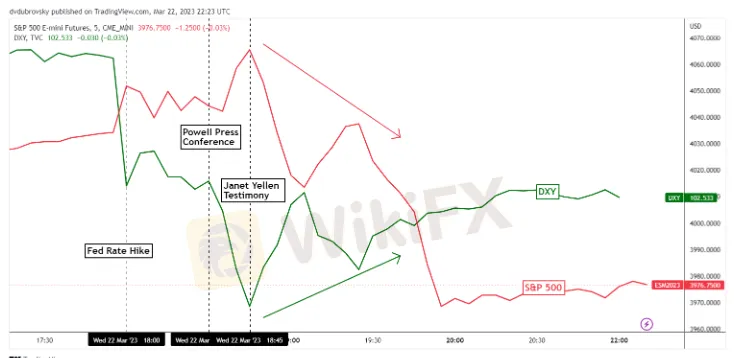简体中文
繁體中文
English
Pусский
日本語
ภาษาไทย
Tiếng Việt
Bahasa Indonesia
Español
हिन्दी
Filippiiniläinen
Français
Deutsch
Português
Türkçe
한국어
العربية
S&P 500 Sinks After Powell Speech and Yellen Testimony, Will US Dollar Rebound?
Abstract:The S&P 500 sank 1.6% on Wednesday in the aftermath of March’s Federal Reserve interest rate decision and accompanying press conference from Chair Jerome Powell.
S&P 500, US DOLLAR, JEROME POWELL, JANET YELLEN – ASIA PACIFIC MARKET OPEN:
The S&P 500 sank 1.6% in the aftermath of the Fed rate decision
Chair Jerome Powell tried pouring cold water on rate cut bets
Meanwhile, Janet Yellen testimony compounded risk aversion
Asia-Pacific markets appear to be bracing for volatility next
Asia-Pacific Market Briefing – Markets Reverse Gains on Fed Rate Decision
The S&P 500 sank 1.6% on Wednesday in the aftermath of Marchs Federal Reserve interest rate decision and accompanying press conference from Chair Jerome Powell. The central bank raised borrowing costs by 25 basis points, bringing the target range to 4.75% - 5%. Initially, markets welcomed the event as the statement noted that policymakers “anticipate” some extra firming might be appropriate.
That was cautiously downgraded from “ongoing increases” in the February statement, which was before Silicon Valley Bank collapsed earlier this month, triggering financial woes in the bank sector. But, markets turned after Jerome Powell noted that officials “just don‘t” see the case for rate cut this year. Since SVB’s bankruptcy, markets have been aggressively pricing in rate cuts this year.
A closer look reveals that median FOMC interest rate projections are still far more hawkish than what markets expect this year. Powell also stressed that if need be, they will raise rates higher than expected. The central bank also stressed that US banks are sound and resilient. Meanwhile, during Powells press conference, Treasury Secretary Janet Yellen was delivering testimony.
She noted that the government is not looking at offering “blanket” deposit insurance to stabilize the banking sector. This amplified selling pressure in regional banks, with First Republic Bank down over 15% by the end of the day. In the chart below, you can get a better idea of how price action evolved throughout these events and how the S&P 500 reversed and the US Dollar bottomed.
With that in mind, this is leaving Asia-Pacific markets vulnerable heading into Thursday‘s trading session. A lack of economic event risk is placing the focus on general market sentiment. As such, follow-through could dampen the mood for Japan’s Nikkei 225 and Hong Kongs Hang Seng Index. This may also offer some light for the US Dollar.

On the daily chart, the S&P 500 left behind a Bearish Engulfing candlestick. This followed what appears to have been a false breakout under a near-term falling channel from February. Further downside progress could open the door to resuming the downtrend. Immediate support is the 38.2% Fibonacci retracement level at 3938. Resistance is the 23.6% point at 4041.


Disclaimer:
The views in this article only represent the author's personal views, and do not constitute investment advice on this platform. This platform does not guarantee the accuracy, completeness and timeliness of the information in the article, and will not be liable for any loss caused by the use of or reliance on the information in the article.
Read more

CySEC Launches Redesigned Website Packed with New Features
CySEC unveils a redesigned website with advanced search tools, centralized resources, and a news section, enhancing accessibility, transparency, and user experience.

Webull Canada Expands Options Trading to TFSAs and RRSPs
Webull Canada launches options trading for TFSAs and RRSPs, offering Canadian investors tax-free growth and retirement savings optimization opportunities.

WikiFX Review: Is IQ Option trustworthy?
IQ Option is catching our eye as it seems to be a trending topic. For those who want to know whether IQ Option is a reliable broker, WikiFX made this article to help you better understand this broker.

Pros and Cons of Choosing Unregulated Forex Brokers
Discover the pros and cons of unregulated forex brokers, explore risks, benefits, and key features, and learn how to evaluate their credibility with the WikiFX app.
WikiFX Broker
Latest News
ASIC Sues HSBC Australia Over $23M Scam Failures
Trader Turns $27 Into $52M With PEPE Coin, Breaking Records
Singaporean Arrested in Thailand for 22.4 Million Baht Crypto Scam
Elderly Trader Loses RM2.1M in WhatsApp Forex Scam
Spotware Unveils cTrader Store, Global Marketplace for Algo Creators
Gigamax Scam: Tracking Key Suspects in RM7 Million Crypto Fraud
WikiFX Review: Is IQ Option trustworthy?
Understanding the Impact of Interest Rate Changes on Forex Markets
FCA Seeks Input to Shape UK Crypto Market Regulations
Broker Review: Is Eightcap Legit?
Currency Calculator


